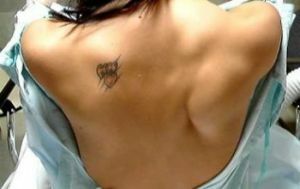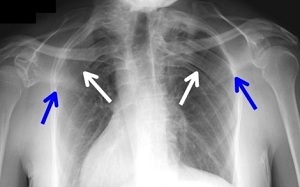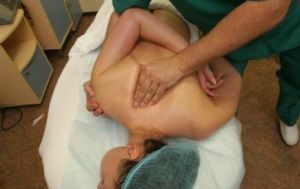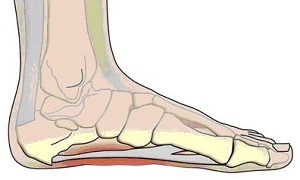 The left and right shoulder blades, which are part of the upper human shoulder belt, serve to connect with the clavicle and humerus and to attach several pectoral muscles.
The left and right shoulder blades, which are part of the upper human shoulder belt, serve to connect with the clavicle and humerus and to attach several pectoral muscles.
Through the clavicle-acromial joint, the full volume of movements in the shoulder joint, lifting, retraction, rotation of the arms is achieved.
With the posterior surface of the thorax and the spine, the scapula is connected by muscles and fascia. Only the strength of the anterior dentate and rhomboid muscles keeps them in a normal physiological position.
Muscle weakening for various reasons, a violation of their innervation due to damage to the long thoracic nerve leads to the appearance of the pterygoid shoulder syndrome.
In this case, the distance between the edge of the blade facing the spine, its lower corner and the ribs increases significantly. She sinks a little lower and leans out from beneath her skin, resembling a bird's wing.
The volume of movements in the shoulder joint is limited, there is difficulty in lifting, pulling forward and withdrawing the shoulder in conjunction with aching pain, lost ability to work.
Causes of
pterygoid scapula There are only a few dozen cases of pterygoid scapula known, this is a relatively rare pathology. The causes leading to the syndrome can be divided into two groups: congenital and acquired.
To an innate pterygoid shoulder blade leads to anatomical defects, developmental disorders and innervation of muscles that support the normal position of the scapula( anterior dentate, trapezoidal, rhomboid).
Syndrome, acquired during life, can appear both in the pathology of the muscles and in the lesion of the long nerve of the chest.
This happens when injuries, tears and sprains, inflammatory processes( neuritis, myositis), with hereditary syndrome of progressive muscular dystrophy, with poliomyelitis( a very rare reason, since almost all are vaccinated against this infection).
Injury is the most frequent starting point, it can be sports or household. Long-term weight-bearing on the shoulder ends with inflammation of the long thoracic nerve or myositis, and a sharp rise in the load can lead to rupture of the muscles.

Diagnostic techniques
The diagnosis of the pterygoid scapula syndrome is based on patient complaints, clinical picture and additional research methods, laboratory and instrumental.
If a syndrome occurs due to trauma or inflammation, the first complaint becomes pain. Its localization is the scapular region with irradiation into the clavicle or humerus, the character of the pain is aching, intensifying with movement.
The second and characteristic complaint is the limitation of movements in the shoulder. If the cause is innate factors, then this complaint comes out on top.
When a patient is examined, the pterygoid shoulder can not be missed. A distinct asymmetry of the left and right scapular

is typical. In the photo, the pterygoid scapula on the
MRI scopes, the bulging of the inner edge of the scapula, increasing when the hand is raised with the help of an assistant, the total volume of movements is impossible. The very first test for diagnosis - a characteristic type of scapula when the patient stretches outstretched hands in the wall.
Despite the specificity of complaints and clinical picture, a differential diagnosis of the syndrome with other diseases always involves a laboratory and instrumental examination.
Shoulder radiculopathy, various bone pathologies and neurological syndromes should be excluded. The X-ray picture will allow to exclude defeat of the scapular bone, electromyography and MRI will help in the diagnosis of the pathology of the long thoracic nerve.
The goals and therapies of
The aims of the therapy are to fix the shoulder blade in the desired position, to provide movements in the shoulder joint in all planes, to remove the pain syndrome, to stop the inflammatory process, to ensure normal blood supply and innervation of the affected area, to prevent disabilityand his disability.
Treatment of the pterygoid scapula can be prolonged, requiring repeated conservative courses, with ineffectiveness of which surgical intervention is prescribed.
It is necessary to get rid of factors that lead to permanent traumatization of the long thoracic nerve or muscles( carrying a load on the shoulder, frequent repetitive movements in the shoulder joint).
To stabilize the scapula, orthopedic retainers are recommended. Analgesics, non-steroidal anti-inflammatory drugs( Diclofenac intramuscularly) are prescribed for pain and inflammation syndrome. 
A good result is observed when using physiotherapy:
- electrophoresis with drugs;
- heat and cold applications;
- massage;
- use of electric current;
- magnetic fields;
- laser.
Surgery for pterygoid scapular syndrome is necessary if repeated courses of conservative therapy are ineffective.
Surgical intervention may be of a functional nature, consisting in replacing the affected anterior toothed muscle with a healthy one( plastic muscle), or stabilizing, in which the scapula is fixed to the rib.
With the second method, the volume of movements is not completely restored.
Complications after
operation With functional and stabilizing surgery methods, some complications are possible, as with any surgical intervention.
In 18% of all operated patients, general or specific complications develop after 1-3 days. Common wound infection, atelectasis of the lungs, thrombosis of blood vessels.
Specific complications are typical for a particular type of intervention. When treating the pterygoid scapula, it is possible to disrupt the innervation of the transplanted muscle, damage to the tendons or neuromuscular bundles.
Rehabilitation after surgery is performed in the profile sanatoriums mainly in its climatic zone. Repeated courses of restorative treatment are often required.
The sanatorium-and-spa stage provides a comprehensive and individual approach to each patient, guarantees a positive effect.
Features of pathology in children
 The most common cause of the syndrome of the pterygoid scapula in children - a violation of posture.
The most common cause of the syndrome of the pterygoid scapula in children - a violation of posture.
Scoliosis of different degrees leads to weakening of the pectoral muscles holding the scapula.
The twisted spine causes deformation of the entire shoulder girdle, making it difficult to supply muscles with oxygen and nutrients.
Muscles lose strength, partially atrophy, with weakening of immunity, or with improper wearing of a school bag, may join myositis or inflammation of the long thoracic nerve. In this situation, the development of the pterygoid shoulder syndrome is very possible.
To diagnose pathology should be as early as possible in order to start treatment in time. Attentive parents can easily determine the presence of a problem.
Visual examination of schoolchildren at annual medical examination, sending them to the examination and subsequent control are included in the functional duties of the school doctor.
The less pronounced the violation of posture, the more likely that the pterygoid shoulder can be cured. In childhood, a huge positive effect is observed with repeated courses of massage and physiotherapy.
Manual massage kneads pectoral muscles, strengthens blood circulation in them, restores muscle fibers. The motor activity trains the muscles, restores the static of the entire support apparatus. 
It is recommended to engage in all possible sports: swimming, skiing, skating, biking. The child should sit as little as possible at the computer or in front of the TV, he must move more, jump and run.
Congenital pterygoid scapula is diagnosed in the maternity home or in the first months of the child's life. Depending on the nature of the pathology, if possible, specific treatment, conservative or surgical, is performed.
Early diagnostics of a syndrome, timely and correct choice of a method of treatment play the major role in preservation of work capacity of the person and its habitual style of life.



